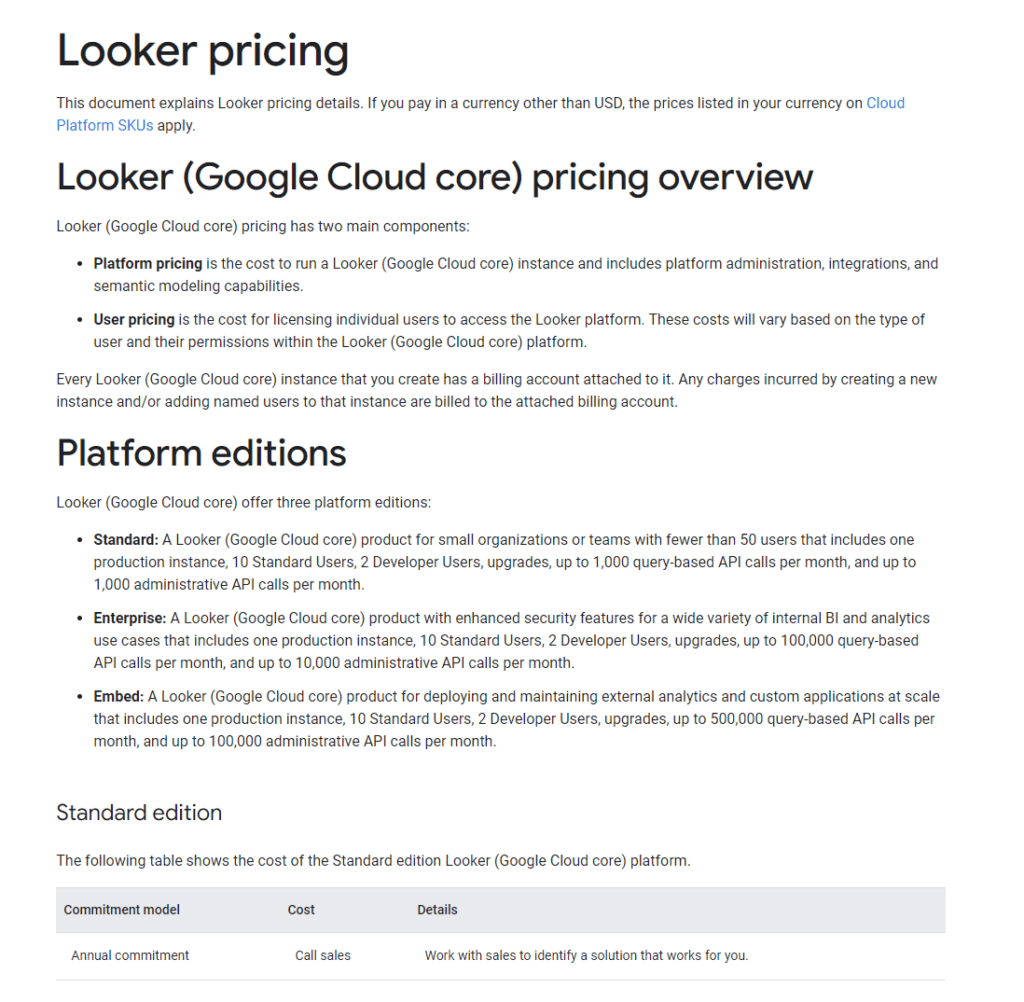Embarking on the quest to find the best CRM tool for your business can feel like setting sail across a vast digital sea. In this ocean of options, two notable vessels, Looker and Heap, beckon with the promise of guiding you to the shores of data-driven decision-making. Each tool boasts unique features and capabilities designed to navigate the complex currents of customer relationship management. But which will lead you to the treasure of invaluable insights? Let’s dive into their approaches to Data Insights and Analytics to begin charting our course.
| Looker | Heap |
|---|---|
 | |
| G2 Score -4.4 out of 5 | G2 Score -4.4 out of 5 |
| TrustRadius Score -8.0 out of 10 | TrustRadius Score -8.2 out of 10 |
Data Insights and Analytics: The Compass of Decision-Making
In the realm of digital marketing and customer engagement, the ability to interpret the vast seas of data into actionable insights is paramount. Here’s how Looker and Heap fare in transforming data into a reliable compass for business strategy.
Looker: The Cartographer’s Dream
Looker takes on the role of a meticulous cartographer, offering a platform that allows businesses to delve deep into their data oceans and chart out every detail. It’s designed for those who not only seek to navigate through their current data landscape but also to discover new territories. With Looker, you’re equipped with a powerful suite of data modeling and analytics tools that enable the creation of custom reports and dashboards tailored to your business’s unique needs and questions.
Looker’s approach to data insights and analytics is akin to crafting detailed, custom maps that guide your strategic decisions with precision. It empowers users to explore beyond surface-level analytics, uncovering hidden insights that can lead to transformative decisions. For organizations with complex data environments or those requiring granular control over their analytics, Looker offers the depth and flexibility to navigate through the most intricate data waters.
Heap: The Agile Navigator
Heap, on the other hand, positions itself as the agile navigator of the analytics world. It specializes in providing real-time insights into user interactions across your digital platforms, from your website to your mobile app. Heap automatically captures every click, form submission, page view, and more, without requiring you to define what to track upfront. This ensures that you’re never missing a piece of data that could be the key to understanding your customers’ journeys.
Where Heap shines is in its ability to quickly turn this vast collection of user interactions into clear, actionable insights. With its user-friendly interface and powerful analytics capabilities, Heap enables businesses to identify trends, pinpoint areas for improvement, and understand the impact of changes in real-time. For companies that value speed and flexibility in their analytics approach, Heap provides the tools to swiftly chart a course through the ever-changing behaviors and preferences of their audience.
Pricing and Value: The Treasure Maps Unveiled
Every captain knows the importance of managing their treasure wisely. Let’s decipher the pricing maps of Looker and Heap to understand which tool offers the gold you need to conquer the digital seas.
Looker: Customized Treasures

Looker approaches pricing with a map that requires a bit of navigation alongside their team. It doesn’t offer a one-size-fits-all pricing structure visible to all who land on its shores. Instead, Looker prefers to tailor its pricing to the size of your crew, the breadth of your voyage, and the depth of the treasures you seek. This means engaging in a dialogue to outline your needs, from which Looker crafts a package that fits your business perfectly.
This bespoke approach to pricing ensures that businesses pay for precisely what they need, no more, no less. While this customized treasure map can lead to a trove perfectly aligned with your objectives, it also means that understanding the initial cost requires a commitment to embark on preliminary discussions with Looker’s team.
Heap: Clear Pricing Waters

Heap, in contrast, sails a course of clear, transparent pricing waters. It offers defined pricing tiers on its website, allowing businesses to quickly see what Heap can offer and at what cost. From a free tier designed for smaller vessels just starting their voyage, to scalable plans that grow with your business, Heap ensures that captains can easily find a package that matches their current expedition and future conquests.
This transparency in pricing makes it simpler for businesses to make a decision and set sail with Heap, knowing the value they can expect to derive from the outset. Heap’s approach is particularly valuable for swift-moving ships looking to make rapid decisions without the need for lengthy negotiations or custom pricing discussions.
Integration Capabilities: Forging Alliances in the Digital Realm
In the grand scheme of digital marketing and analytics, the power of a tool is often magnified by its ability to integrate smoothly with other platforms—be it marketing automation software, CRM systems, data storage solutions, or e-commerce platforms. Here’s how Looker and Heap stand in terms of building these essential alliances.
Looker: The Architect of Integration
Looker approaches integration with the precision of a seasoned architect, designing its platform to serve as the cornerstone of your data infrastructure. It boasts robust integration capabilities with a wide array of databases, business intelligence tools, and marketing platforms. This is made possible through Looker’s extensive API, which allows for deep custom integration, ensuring that data can flow seamlessly between Looker and other tools in your arsenal.
The strength of Looker in this realm is its adaptability—allowing businesses to construct a bespoke analytics environment that fits perfectly within their existing digital ecosystem. Whether it’s enhancing a CRM with deeper data insights, connecting to e-commerce platforms for real-time sales analysis, or integrating with marketing tools to track campaign performance, Looker’s architecture ensures that the foundations of your data strategy are solid and cohesive.
Heap: The Agile Connector
Heap, with its focus on user behavior analytics, champions agility in its integration approach. It offers straightforward, plug-and-play integrations with a variety of tools that are central to digital marketing strategies, including CRMs, email marketing platforms, and A/B testing tools. Heap’s strength lies in its ability to quickly capture and utilize data from these platforms, enriching its analytics with external insights to provide a comprehensive view of the customer journey.
The simplicity and efficiency of Heap’s integrations make it an ideal ally for businesses looking to enhance their tech stack without extensive customization work. This agility is particularly valuable for rapidly evolving businesses that prioritize speed and flexibility in their operations. With Heap, the focus is on ensuring that valuable user insights are readily available, fueling data-driven decisions across the organization.

Related: Check out our free SEO suite

Customer Support and Educational Resources: Beacons of Guidance
The quest for data-driven excellence is ongoing, and the availability of robust customer support and comprehensive educational resources plays a pivotal role in navigating this journey successfully. Let’s see how Looker and Heap fare in supporting their users’ quests for knowledge and mastery.
Looker: The Grand Library
Looker is akin to a grand library, with vast archives of knowledge and numerous guides available for those who seek to deepen their understanding of data analytics. Looker offers an extensive array of educational resources, including detailed documentation, how-to guides, video tutorials, and webinars that cover everything from basic functionality to advanced data modeling techniques. This wealth of information ensures that users can find answers to their questions and expand their skill set at their own pace.
In addition to self-service resources, Looker provides dedicated customer support to address more complex inquiries and challenges. Users can reach out via email, phone, or through a support ticket system, depending on their plan. Looker also fosters a community of users through forums and user groups, encouraging the sharing of insights, strategies, and solutions among peers.
Heap: The Agile Academy
Heap approaches user support and education with the agility of an academy designed for rapid learning and application. Recognizing that speed is of the essence in today’s fast-paced business environment, Heap provides a streamlined collection of educational resources that get users up to speed quickly. These resources include concise documentation, quick-start guides, and targeted tutorials focused on leveraging Heap’s analytics for immediate impact.
Heap’s customer support is responsive and user-friendly, with options for live chat and email support to help users navigate any hurdles swiftly. The emphasis is on ensuring that users can not only resolve their issues quickly but also apply Heap’s insights to make data-driven decisions without delay. Additionally, Heap offers webinars and a blog filled with practical advice, tips, and best practices to help users maximize the value they derive from the platform.
Scalability and Flexibility: Navigating Growth and Change
In the quest for market dominance, the scalability and flexibility of the tools at your disposal can define the speed and agility of your ascent. Let’s examine how Looker and Heap equip businesses to scale their operations and flexibly adapt to new challenges and opportunities.
Looker: Building Empires
Looker is designed with the architecture of an empire in mind, providing a robust foundation upon which businesses can build and expand without fear of outgrowing their analytics platform. Its powerful data modeling capabilities, coupled with a deep integration ecosystem, mean that Looker can handle increasingly complex data environments and more sophisticated analytical needs as a business grows.
The platform’s flexibility is evident in its customizable dashboards and reports, which can be tailored to the evolving questions and KPIs that businesses face as they scale. Furthermore, Looker’s commitment to a BI platform that integrates seamlessly with a wide range of databases and third-party tools ensures that no matter how a business evolves, its data analytics can adapt in stride, providing consistent, reliable insights across the entire organization.
Heap: Agile Adaptation
Heap offers a different kind of scalability and flexibility, one that emphasizes agility and the ability to quickly iterate on product offerings based on real-time user data. Its automatic data capture means that from the moment Heap is integrated, it begins collecting a comprehensive dataset of user interactions, allowing businesses to scale their analytics efforts without needing to predefine specific events or interactions to track.
This approach not only eliminates the potential for data gaps but also ensures that Heap can flexibly adapt to new user behaviors, features, and products as they are developed. The platform’s intuitive interface and straightforward analytics tools allow businesses to quickly derive insights and make data-driven decisions, essential capabilities for companies in fast-paced industries or those undergoing rapid growth.
Conclusion
As we conclude our detailed exploration of Looker and Heap, navigating through the essential facets that define a tool’s capability to transform data into actionable insights and strategic advantage, we’ve charted a course through the Data Insights and Analytics, Integration Capabilities, Customer Support and Educational Resources, and finally, the crucial waters of Pricing and Value. Each of these territories has revealed the strengths and navigational aids offered by Looker and Heap, guiding us to understand their potential as allies in the quest for digital marketing success.
READ NEXT:
- Bitrix24 vs Vtiger: The Best CRM Tool for You
- MicroStrategy vs Heap: The Best Analytics Tool for You
- 11 Marketing Analytics Tools to Elevate Your Data-Driven Strategies
- Looker vs MonsterInsights: The Best Analytics Tool for You
- “GoSquared vs Kissmetrics: The Best Analytics Tool for You”
- 29+ Digital Analytics Software to Skyrocket Your Digital ROI
- Amplitude vs Looker: The Best Analytics Tool for You






















Comments are closed.